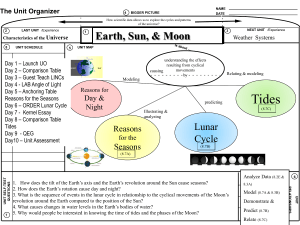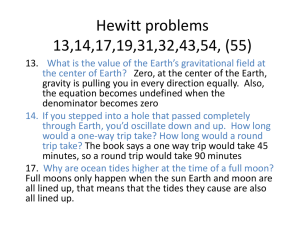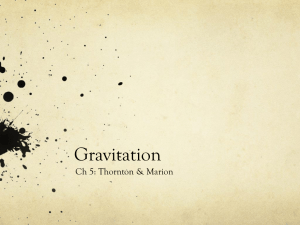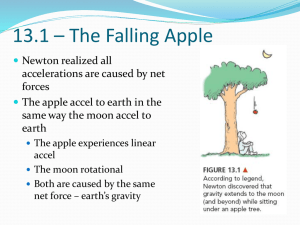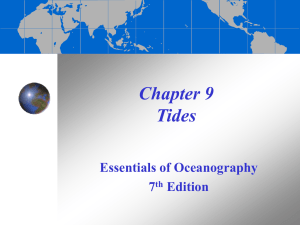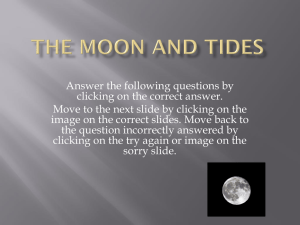Tides and Water Levels
advertisement
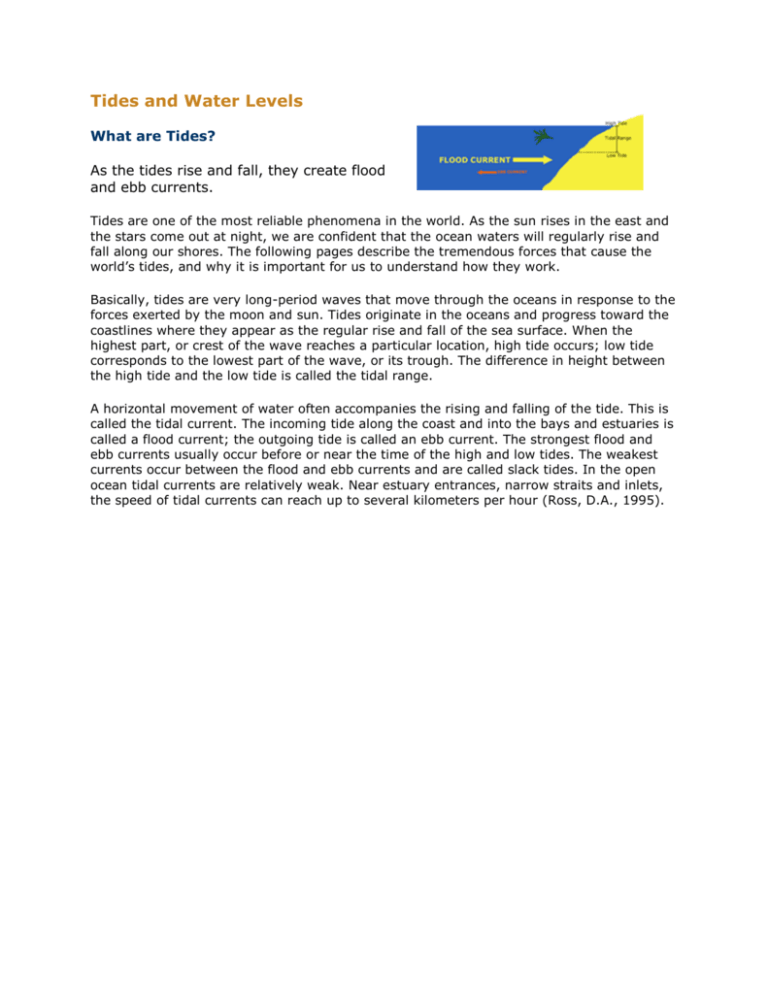
Tides and Water Levels What are Tides? As the tides rise and fall, they create flood and ebb currents. Tides are one of the most reliable phenomena in the world. As the sun rises in the east and the stars come out at night, we are confident that the ocean waters will regularly rise and fall along our shores. The following pages describe the tremendous forces that cause the world’s tides, and why it is important for us to understand how they work. Basically, tides are very long-period waves that move through the oceans in response to the forces exerted by the moon and sun. Tides originate in the oceans and progress toward the coastlines where they appear as the regular rise and fall of the sea surface. When the highest part, or crest of the wave reaches a particular location, high tide occurs; low tide corresponds to the lowest part of the wave, or its trough. The difference in height between the high tide and the low tide is called the tidal range. A horizontal movement of water often accompanies the rising and falling of the tide. This is called the tidal current. The incoming tide along the coast and into the bays and estuaries is called a flood current; the outgoing tide is called an ebb current. The strongest flood and ebb currents usually occur before or near the time of the high and low tides. The weakest currents occur between the flood and ebb currents and are called slack tides. In the open ocean tidal currents are relatively weak. Near estuary entrances, narrow straits and inlets, the speed of tidal currents can reach up to several kilometers per hour (Ross, D.A., 1995). Tides and Water Levels What Causes Tides? The relationship between the masses of the Earth, moon and sun and their distances to each other play critical roles in affecting tides. Gravity is one major force that creates tides. In 1687, Sir Isaac Newton explained that ocean tides result from the gravitational attraction of the sun and moon on the oceans of the earth (Sumich, J.L., 1996). Newton’s law of universal gravitation states that the gravitational attraction between two bodies is directly proportional to their masses, and inversely proportional to the square of the distance between the bodies (Sumich, J.L., 1996; Thurman, H.V., 1994). Therefore, the greater the mass of the objects and the closer they are to each other, the greater the gravitational attraction between them (Ross, D.A. 1995). Tidal forces are based on the gravitational attractive force. With regard to tidal forces on the Earth, the distance between two objects usually is more critical than their masses. Tidal generating forces vary inversely as the cube of the distance from the tide generating object. Gravitational attractive forces only vary inversely to the square of the distance between the objects (Thurman, H.V., 1994). The effect of distance on tidal forces is seen in the relationship between the sun, the moon, and the Earth’s waters. Our sun is 27 million times larger than our moon. Based on its mass, the sun's gravitational attraction to the Earth is more than 177 times greater than that of the moon to the Earth. If tidal forces were based solely on comparative masses, the sun should have a tidegenerating force that is 27 million times greater than that of the moon. However, the sun is 390 times further from the Earth than is the moon. Thus, its tide-generating force is reduced by 3903, or about 59 million times less than the moon. Because of these conditions, the sun’s tide-generating force is about half that of the moon (Thurman, H.V., 1994). Tides and Water Levels Gravity, Inertia, and the Two Bulges Two tidal bulges are created on opposite sides of the Earth due to the moon's gravitational force and inertias counterbalance. The gravitational attraction between the Earth and the moon is strongest on the side of the Earth that happens to be facing the moon, simply because it is closer. This attraction causes the water on this “near side” of Earth to be pulled toward the moon. As gravitational force acts to draw the water closer to the moon, inertia attempts to keep the water in place. But the gravitational force exceeds it and the water is pulled toward the moon, causing a “bulge” of water on the near side toward the moon (Ross, D.A., 1995). On the opposite side of the Earth, or the “far side,” the gravitational attraction of the moon is less because it is farther away. Here, inertia exceeds the gravitational force, and the water tries to keep going in a straight line, moving away from the Earth, also forming a bulge (Ross, D.A., 1995). In this way the combination of gravity and inertia create two bulges of water. One forms where the Earth and moon are closest, and the other forms where they are furthest apart. Over the rest of the globe gravity and inertia are in relative balance. Because water is fluid, the two bulges stay aligned with the moon as the Earth rotates (Ross, D.A., 1995). The sun also plays a major role, affecting the size and position of the two tidal bulges. The interaction of the forces generated by the moon and the sun can be quite complex. As this is an introduction to the subject of tides and water levels we will focus most of our attention on the effects of the stronger celestial influence, the moon. Tides and Water Levels Frequency of Tides - The Lunar Day Unlike a 24-hour solar day, a lunar day lasts 24 hours and 50 minutes. This occurs because the moon revolves around the Earth in the same direction that the Earth rotates around its axis. Most coastal areas, with some exceptions, experience two high tides and two low tides every lunar day (Ross, D.A., 1995). Almost everyone is familiar with the concept of a 24hour solar day, which is the time that it takes for a specific site on the Earth to rotate from an exact point under the sun to the same point under the sun. Similarly, a lunar day is the time it takes for a specific site on the Earth to rotate from an exact point under the moon to the same point under the moon. Unlike a solar day, however, a lunar day is 24 hours and 50 minutes. The lunar day is 50 minutes longer than a solar day because the moon revolves around the Earth in the same direction that the Earth rotates around its axis. So, it takes the Earth an extra 50 minutes to “catch up” to the moon (Sumich, J.L., 1996; Thurman, H.V., 1994). Because the Earth rotates through two tidal “bulges” every lunar day, coastal areas experience two high and two low tides every 24 hours and 50 minutes. High tides occur 12 hours and 25 minutes apart. It takes six hours and 12.5 minutes for the water at the shore to go from high to low, or from low to high. Tides and Water Levels Tidal Variations - The Influence of Position and Distance Together, the gravitational effects of the moon and the sun affect the Earth’s tides on a monthly basis. The moon is a major influence on the Earth’s tides, but the sun also generates considerable tidal forces. Solar tides are about half as large as lunar tides and are expressed as a variation of lunar tidal patterns, not as a separate set of tides. When the sun, moon, and Earth are in alignment (at the time of the new or full moon), the solar tide has an additive effect on the lunar tide, creating extra-high high tides, and very low, low tides—both commonly called spring tides. One week later, when the sun and moon are at right angles to each other, the solar tide partially cancels out the lunar tide and produces moderate tides known as neap tides. During each lunar month, two sets of spring tides and two sets of neap tides occur (Sumich, J.L., 1996). Just as the angles of the sun, moon and Earth affect tidal heights over the course of a lunar month, so do their distances to one another. Because the moon follows an elliptical path around the Earth, the distance between them varies by about 31,000 miles over the course of a month. Once a month, when the moon is closest to the Earth (at perigee), tide-generating forces are higher than usual, producing above-average ranges in the tides. About two weeks later, when the moon is farthest from the Earth (at apogee), the lunar tideraising force is smaller, and the tidal ranges are less than average. A similar situation occurs between the Earth and the sun. When the Earth is closest to the sun (perihelion), which occurs about January 2 of each calendar year, the tidal ranges are enhanced. When the Earth is furthest from the sun (aphelion), around July 2, the tidal ranges are reduced (Sumich, J.L., 1996; Thurman, H.V., 1994).


